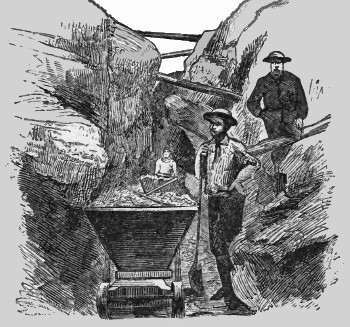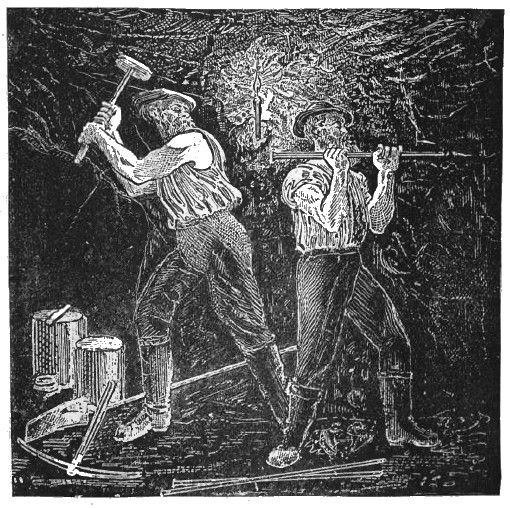Although the scope of this work does not include the very complex problem involved in the working of a great mine, prospecting and the simpler mining operations are so intimately connected that it would not be desirable to make mention of the one and ignore the other, because the prospector must perforce become a miner as soon as he discovers mineral, even though his operations should not go beyond a shallow trial shaft. The simplest method of hoisting dirt or rock out of a shaft, after it has become too deep for the sinker to throw the stuff out with a spade, is by a bucket and windlass, which may be either single or double, according to the power required. In northwestern Canada, where the present gold excitement has attracted so many thousand pioneers, the miners have hitherto been content with a windlass. For their purpose it answers well, as they sink through gravel and not more than thirty feet at the most before reaching the bed rock. The alluvial flats in which the coarse gold of the upper Yukon has been discovered, are composed of gravel that is invariably frozen, summer as well as winter, and which requires to be thawed out before it can be worked with a pick. Strangely enough, dynamite cannot be used, as the ground is so elastic under the frost that the tamping simply blows out and the required effect is not produced.
This peculiar condition has led the men, who are mining in that part of the continent, to adopt methods very similar to those used in Siberia, where, also, the ground is permanently frozen to a great depth. After scratching the surface of the soil, and removing the deep moss that invariably covers it, they light large fires over night and in the morning remove the few inches of thawed soil underneath the ashes. By this painfully slow method they eventually sink to the richer gravel, fifteen or twenty, or even thirty, feet below the surface, though there are few shafts of this depth on the Klondike and the other gold-bearing creeks about which we have heard so much. When the bed rock is reached and the few inches of decayed surface removed, the miner builds his fire against the side of the shaft, placing some inclined logs over it as a roof, and goes to bed. When he awakes next day several feet of the soil have fallen down over the logs, and this he has to hoist. It is at this stage that the windlass worked by his companion, or partner, demonstrates its value. In a very short time all the gravel that the fire has thawed out is hoisted to the surface, and added to the dump, where it must remain until the warmth of summer shall have thawed the streams and permitted sluicing.
A sluice is really nothing more nor less than a trough, open at the top, in which the gold is sorted from the lighter gravel and dirt by running water. The grade varies according to the coarseness of the gold. Very fine gold would be carried away by too swift a current, while coarse gold will resist almost a torrent. The sluice is built in joints, usually a dozen feet in length ; the sides may be six inches or a foot deep, and the width varies from one to two feet. There is no rule in this matter, but owing to the extravagant price of lumber as much as a hundred and fifty dollars a thousand feet, board measure the tendency is to make the sluices very small and very short, thereby saving nothing but the very coarsest gold. A properly constructed sluice should be several hundred feet in length, and the inclination should not be more than one foot in twelve, while it may, in a case of fine gold, be advisable to diminish this inclination by at least a fourth. Riffles, or cross-pieces, are placed across the sluice at intervals of a few feet, and slats are placed lengthwise, filling up the intervals between the riffles. Into the crevices and interstices of these obstructions the heavy gold sinks by its own weight, and every few days, or weeks, as the case may warrant, the miner shuts off the water by closing the gate at the head of the sluice, removes the slats and riffles, beginning at the joint nearest the head and working towards the tail of the sluiceway, and collects all the gold that has accumulated.
The horse whim is used in developing many a western prospect. The windlass does not work well below forty feet, and where fuel and water are to be had any sensible man will use steam power for deep mining, but there is a gap between the windlass and the steam hoist which the horse whim fills acceptably. To a depth of 300 feet a horse whim can usually handle the rock and water. It is inexpensive, in the first outlay, and costs but little to run. You can bring your bucket from a shaft a hundred and fifty feet deep in two and a half minutes, and with a seven hundred pound capacity in the bucket, in forty-five trips you could raise fifteen tons a day. A shaft three hundred feet deep would require four hours' steady work to bring to surface the same amount. A fair speed with a one-horse whim from a three hundred foot shaft is one hundred buckets per shift of ten hours, but the prospector rarely has to figure on shafts of that depth. If the mine turns out well it is likely to be in the 'hands of a powerful company (of which he should be the principal shareholder) before the three hundred foot level is reached. The weight of the horse whim is about eight hundred pounds. It can be taken to pieces and packed anywhere that a mule can travel; the heaviest piece will not weigh more than a hundred pounds.
A small stamp mill, run by horse power, is a very favorite machine with western men, where the ore is free milling. The mortar in which the stamps work has copper plates amalgamated with mercury inside, and copper tables with amalgamated plates over which the pulp passes after oozing through a fine screen in front of the mortar. These little mills are so constructed that they can be taken apart or put together in an hour or two. They require but one horse power and will do good clean work up to their capacity. A diamond drill is a most useful adjunct to exploration of a mine or deposit. It is, essentially, a hollow drill which may be lengthened at will, rotating rapidly and carrying a crown of "bort" or black diamonds at its extremity, that eats into the strata very quickly. Holes 3,000 feet deep have been driven by the diamond drill, but such extensive investigations of the earth's crust are tremendously costly, and may only be undertaken by governments or rich companies. For a depth of 700 feet, however, the expense need not exceed $2,100. The cost of the plant for drilling would be $3,500 more. Water is pumped down the hollow center of the drill, to keep it cool. The great advantage of the diamond over the percussion drill is that it permits the saving of a core, so that the character of the rocks and minerals passed through may be known. The diamond drill does better work in hard strata than it does in soft. The rate, in limestone, may be about two feet an hour, down to a depth of 200 feet.
Continue on to:
Becoming A Prospector For Gold And Silver Ores, Part I
Return To:
Gold And Silver Basic Prospecting Methods


